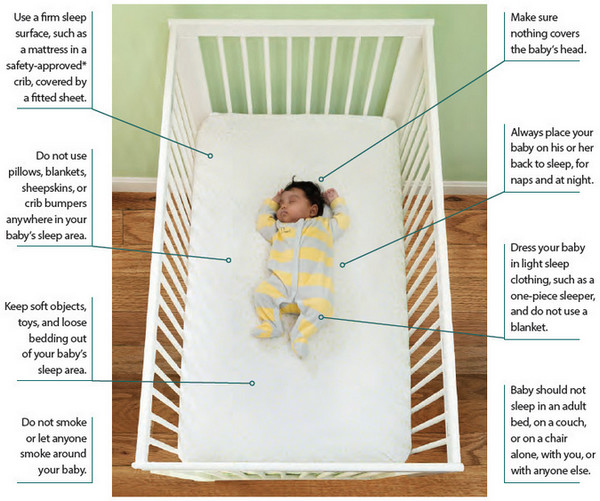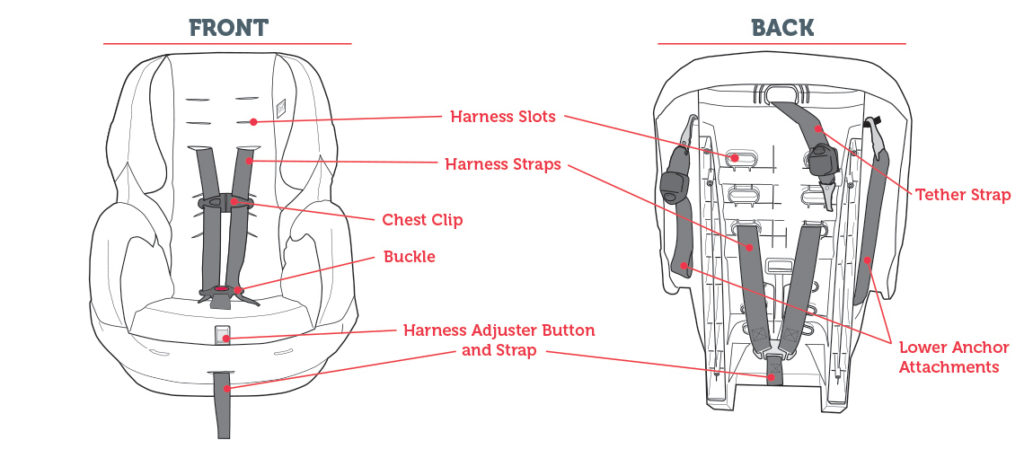Becoming a parent can be overwhelming, but we're here to help take the guess work out of keeping your child safe! The resources and education that we provide are based on years of industry research from reliable organizations supported by the American Academy of Pediatrics. Our Injury Prevention team wants your little one to stay safe and healthy, so check out the topics on this page for great tips and information on infant safety.
-
Infant safe sleep has long been studied, debated, and analyzed. The purpose of safe sleep recommendations is to help protect your baby from choking, suffocation, and Sudden Infant Death Syndrome (SIDS).
Sometimes, families opt to bed-share for cultural reasons, due to lack of space, convenience of late night feeding sessions, or just out of sheer love of baby snuggles. However, bed-sharing is the most common cause of death in babies under 3 months old (per the American Academy of Pediatrics). You can have your baby in the same room, and really close to where you sleep; just make sure that they're not in the same bed.

Other safety tips
- Your baby's bed does not need to be large or expensive
- Don't place your baby's bed near window cords or electrical wires
- Keep the room at a comfortable temperature
- Don't let baby sleep in a carrier, sling, car seat, or stroller.
- Don't use cribs with drop-side rails
More on the 2022 law banning most crib bumpers and inclined sleepers for infants
Resources
American Academy of Pediatrics Safe Sleep Overview
Safe Sleep for Babies Act (effective November 12, 2022)
What Does a Safe Sleep Environment Look Like?
Image courtesy of the HealthAlliance Hospital, for educational purposes only; https://www.hahv.org/safe-sleep-education
-
It is important to follow these safety rules when bathing your baby:
- Keep the room warm so your baby does not get cold. Bathe your baby quickly to avoid chilling.
- Keep water around 100° Fahrenheit (F) or 37.8° Celsius (C). Test the water with a bath thermometer, your elbow, or your wrist. The water should feel warm, not hot.
- Set water heaters at 120°F (48.9°C) to prevent burns.
- Keep one hand on your baby at all times.
- Never leave your baby alone in any amount of water.
American Academy of Pediatrics Bathtub Safety Overview
Resources:
-
We're often asked, "Which car seat is the best car seat for my child?"
Here's the answer: the best car seat is one that the parents can install easily, correctly, EVERY. SINGLE. TIME. We don't want you to struggle. We want you to feel confident that you can install a car seat, so we're sharing the most important considerations that parents should use in choosing their baby's car seat.
- Select a car seat based on your child's age and size.
- Select a car seat that fits in your vehicle.
- Always refer to your car seat manufacturer's instructions for height and weight limits.
- Always refer to your vehicle owner's manual on how to install the car seat using the seat belt or lower anchors and tether (if available).

(Image courtesy of Safe Kids Worldwide)
- Make sure baby is properly buckled EVERY TIME. Straps should be snug (not cutting off circulation), with the chest clip level with their armpits; the buckle straps should be snug on the child's hips; and the baby should NEVER wear a puffy jacket while buckled.
- Your child should not sleep in the car seat outside of the car; always transfer them out of the seat and into a safe sleep space. Their head can fall forward and make it difficult for them to breathe. Similarly, if the baby is in the car seat, they should be buckled, even if you're not ready to head out to the car. Too often, unbuckled babies fall out and can be injured.
- Don't rush to move your child to the next larger car seat, as long as the child fits within the manufacturer's height and weight requirements (should also be listed on the side of the car seat or online if you can't find the manual)
- Consider purchasing a second (or third) base to use if the child will frequently travel in another vehicle. If you and your spouse both travel with baby, if you have a family member or babysitter who cares for your child, it can be much easier to install the base, and then you only have to click the car seat in when using it.
- Harness straps should be adjusted to secure your baby properly and should sit at shoulder height or slightly below, never above.
- The buckle can usually be adjusted too, so make sure that it's as close to baby's body as possible without making them uncomfortable.
(Image courtesy of NHTSA.gov)
We currently offer a Free Child Passenger Safety Class virtually on the 3rd Wednesday of the month at 7pm for caregivers. Register for a class!
-
Written Dr. Seran Kim, board-certified Emergency Physician
Newborn babies may seem immobile, all swaddled and sleepy. But they’ll be on the move as early as six months—and it happens fast. So be sure to prep your home well in advance to help prevent household-related injuries.
Infants and children younger than five years old account for over 40% of pediatric Emergency Department (ED) visits. Six of the top 10 reasons for ED visits are for injuries such as bruises, open wounds, sprains and strains, broken arms and other injuries due to external causes.
Many of these common injuries occur in and around the home, so don’t forget to check all of these precautions off your list:
- Cover all unused electrical outlets with plugs to prevent electrical shock.
- Keep all cords out of reach, including electrical cords (which can cause oral electrical burns if baby chews on the wire) as well as cords for blinds (which can be a strangling risk).
- Use a wall anchor to secure TVs, bookshelves and furniture, which are significant topple risks.
- Use protective padding for coffee tables or any furniture with sharp edges.
- Cover your fireplace with an appropriate gate to prevent flame injuries.
- Use safety gates on the top and bottom of stairs.
- Use cabinet locks on lower cabinets and doors.
- Lock medicine cabinets or boxes.
- Lock cleaning supplies. Don’t forget to keep bleach and laundry pods (which may look like candy) out of reach as well!
- Keep house plants out of reach. Some plants (which thankfully do not taste good) may be poisonous if ingested in larger quantities.
- Use window guards and/or move furniture away from windows (which could provide climbing access to toddlers). Windows shouldn’t open more than four inches.
- Lock away any guns separately from ammunition, or if possible, remove any guns/firearms from the house.
- Check for chipping paint, especially in older homes, which can be a lead poisoning risk.
- Use stove knob covers. Be sure to also turn pot handles backwards when in use and use rear burners.
- Cover radiators or heating vents to prevent burn injuries.
- Apply door pinch guards to all doors to prevent finger crush injuries.
- Use toilet locks, as even one inch of water can pose a drowning risk.
- Lock your liquor cabinet.
- Lock away batteries, especially button batteries, which can lead to serious injury or death if placed in the nose/ears or ingested.
- Avoid games with marbles or small balls or beads, or any small part smaller than one and three-quarter inches, which are common choking hazards.
Remember, prevention is the best safeguard. Thoroughly baby-proofing your home helps prevent accidental injuries and helps you avoid visits to the emergency department.
Factually reviewed by Dr. Seran Kim, board-certified Emergency Physician, on June 9, 2021. Link found here